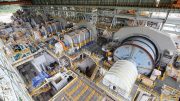Jon Hykawy is the president and director of Stormcrow Capital. He is a research scientist and expert in lithium, the rare earths, fluorspar and tin. Originally training as a physicist, he has gone on to do technical work with rechargeable batteries, fuel cells and solar and wind power. He recently spoke with The Northern Miner about his outlook for battery metals in 2019.
The Northern Miner: Before looking ahead to 2019, is there anything in the battery metal space that really surprised you in 2018?
Jon Hykawy: It’s going to sound slightly arrogant to say, but no. We were telling a story for a while that said, listen: Lithium was in short supply for a short period of time. The price spike was assisted by investors and speculators that came into the space and started to buy material, and they realized there might be a squeeze coming on. At some point not only was the material supply of lithium going to catch up, but then you were going to see the speculators get out of their positions, because why would you want to be in a space where the prices are coming down and you’re holding physical material? I mean, people aren’t in love with this stuff, they want to make a profit. We saw that happen over the last year.
TNM: Is there concern about lithium oversupply?

Stormcrow Capital president and director, Jon Hykawy. Credit: Stormcrow Capital.
JH: Well, there is abundant supply right now. That’s without question. And the price in China is still between US$8,000 and US$11,000 per ton on the spot market. If you’d come to me in 2008 or 2009 and told me lithium companies were going to be getting US$8,000 to US$10,000 for their product, I would have laughed, because the prices were more like US$4,000. So being double that level is not exactly terrifying.
Lithium is never going to be in shortage, but is it going to be massively oversupplied? Well, no, because frankly there’s a limited number of potential sources of really, really cheap lithium. The long-term price for battery-grade chemicals will settle in at around US$10,000 per ton. That’s a reasonable level for the battery industry. It’s a bit expensive for the automotive side of life.
The automotive industry’s solution is not to build out an entirely new electrical grid and recharging stations every place. Their idea is to build weak hybrids, or range extended hybrids. That’s basically a gasoline engine, a diesel engine or a small fuel cell turning a generator, attached to a car that has a small battery pack. The small battery pack is cheap, but it can produce a very large amount of power, so it can handle any level of acceleration within reason. The gasoline, diesel or fuel cell give you the ability to generate electricity on the move.
This solves those infrastructure issues and worries about range limitations that buyers have, but it does it very cost effectively. The other advantage from the point of view of materials is that now I may not need a battery that has the maximum energy density availability. I need a much smaller battery. If I have that, maybe I can use chemistry that doesn’t involve really expensive materials like cobalt. We already have a battery chemistry that does that. If you have any cordless power tools, the battery in those is a lithium battery, but one that contains lithium iron phosphate.
That doesn’t mean cobalt prices are going back to US$4. There are going to be other uses, like your cellphone, your tablet, your laptop — a bunch of designs where you’re limited in terms of size and you want the maximum energy density, and to safely store the maximum amount of energy you can put in these devices. Cobalt’s not directly related to energy density. It is the defining material for improving your safety margins, however. The more energy you stuff into a battery, the more unstable it gets. Cobalt keeps everything from turning into a large accident.
TNM: How do you see the price of lithium performing in 2019?
JH: I don’t see any spike up. We’re not going to get a repeat of 2017, there’s no reason for that to happen. We actually have a couple of headwinds to overcome. Tesla in the U.S., for example, is going to be facing a reduction in subsidies this coming year. They’ve hit limits on production. Supposedly they have run through all the subsidies that are required to get them to scale. Admittedly, they didn’t have a Model 3 at the time, but where we’ve had the subsidies reduced or impinged on in any way for any period of time, Tesla sales have plummeted.
The Chinese have made a point of saying their subsidies will be removed entirely for the battery electric vehicle industry within the next year or two years. There is this feeling within China that they may have jumped the gun on the subsidies and on the industry.
The whole idea with electric vehicles wasn’t to make sure that the Americans didn’t get an uninterrupted run to dominance in the next stage of automobile building, but to clean up the city cores. The problem with that approach in China is that their grid is extremely dependent on coal, whereas the U.S. grid has become increasingly dependent on natural gas. If you plug in an electric vehicle in China, it’s an arguable point about whether you’re actually lowering emissions in any way versus driving a gasoline-powered vehicle. You have moved the emissions — they aren’t coming out of the tail pipe directly behind the car, they’re coming out of a coal-fired power plant at the 6th Ring Road. But if the wind is blowing in the wrong direction, too bad for you.
In other emerging markets, all of this is still true. These grids are highly dependent on coal. And running a battery electric vehicle — it’s not clear that they’re improving the environment in any way, shape or form. So why should governments be subsidizing these vehicles at this point? Those headwinds are going to face the industry.
Hybrid vehicles are not zero-emission vehicles, but what they are is potentially a way to produce a much lower emission vehicle relatively inexpensively, perhaps at a capital expense that’s even better than a gasoline vehicle. If that’s the case, the industry will be moving in that direction eventually, ironically perhaps impeded by this speed bump of battery electric vehicle development that got everyone excited. It’s going to be an interesting next few years in terms of how this all plays out.
In terms of lithium pricing, the trend right now is down. There’s additional supply coming into the market. I expect the prices to stay relatively flat, but it wouldn’t shock me if there was some downward movement.
TNM: And cobalt?
JH: On the cobalt side, for at least the next year, I think you’re seeing flat to down. But after that — look out. There aren’t really any large-scale cobalt projects that could come online on the order of a Katanga that can really, really mitigate against the price increases we’re likely to see from increasing demand.
TNM: Is that upward movement on the cobalt side two, three years out?
JH: I’d say two, just to be safe.
TNM: Stormcrow started zinc coverage early this year. What’s your outlook on zinc for 2019?
JH: You have a number of long-life mines and high-production mines that are coming to their end-of-life. Already a couple of the top-10 projects in the world have essentially shut down, without any easy replacements.
On the demand side, steel use is always going to be the big use of zinc. What we’ve seen is a switch in the last five or 10 years away from “Should I use conventional steel in this project and replace it frequently, versus galvanized material?” to an absolute consensus that galvanized metal beats the tar out of regular, unprotected steels, from a cost-effectiveness point of view.
The argument now has shifted to “should I use galvanized steel versus stainless?” At this point, the data there is leaning pretty heavily to stainless steel being too expensive, and to stick with galvanized.
The other thing that surprised me was that although we’ve always heard about metal-air batteries on some level, there are a couple companies actively selling electrically rechargeable, zinc-air batteries to end users. These are never going to be automotive batteries. They’re never going to be in your cell phone, they’re not energy-dense enough. There’s no possible way to make them work in those regards. But where they do shine is in grid storage. The price points that these companies are working to achieve or have achieved already are at, or better than, the levels of other technologies. And I don’t mean lithium batteries for grid storage. I mean things like pumped hydro and compressed air energy storage, which are sort of the gold standards for grid-level electricity storage.
The electrical generating industry is extremely conservative. They’re going to want to test the hell out of these things for years to come. But it’s an awfully promising-looking technology.
TNM: Do you see any movement with the zinc price in 2019?
JH: I do, and it’s going to come down to a bunch of economic intangibles at this point, like what’s global growth, and how do these trade wars impact demand, and the like. But assuming that we’re not impeded too much by that, there’s a fair chance that we’ll see higher zinc prices in 2019. We just don’t have the supply right now that we like. The right economic choice for a lot of these projects is to use galvanized material. The problem will be whether these projects are getting built at all.
TNM: Anything else in the battery metal space that isn’t on people’s radar, but maybe should be, heading in to 2019?
JH: Up until a short while ago, if someone asked me about graphite and especially about graphene, I would have laughed, because the joke about graphene is it’s the material of the future, and it always will be. Nobody has managed to produce useful graphene at a price point that makes any sense to anybody trying to build a cheap battery.
Graphene has the potential for being useful in batteries. It potentially can hold a much larger number of lithium ions for its weight than graphite can, and has the potential to change the energy density of batteries again. But I’ve come across one private company in Australia that may, I emphasize may, have started to crack that. And if this proves out, it will be an interesting shake up. That’s something I’ll be watching in the early part of the year.






Be the first to comment on "Interview: Stormcrow’s Jon Hykawy gives battery metal outlook for 2019"